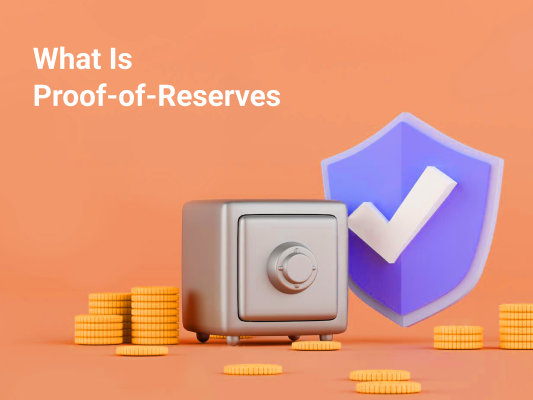
What Is Proof-of-Reserves [Why It’s Critical Your Crypto Exchange Has It]
The most recent collapse of FTX Exchange, as well as platforms such as Celsius, BlockFi, and Voyager Digital, has resulted in strong disbelief in the liquidity of centralized crypto custodians – and for good reason.
Definition
Proof-of-reserves shows that custodians hold the funds they are supposed to hold for their clients.
As a result of a chain of events caused by negligence, misfortune, or full-on malice, investors have shifted their focus and demand proofs that their funds are secure. Most top custodians have obliged.
In this article we’ll discuss what is proof-of-reserves and what it means for the crypto industry.
What Is Proof-of-Reserves?
Proof-of-reserves is a way for crypto exchanges and other centralized custodians to show they have enough on-chain crypto assets on hand.
Of course, proof-of-reserves has to be provided in a proper way in order for it to mean anything. This includes following standard auditing procedures and making the entire process verifiable and transparent.
In order to do that, exchanges use cryptographic proof alongside wallet address ownership verification based on the Merkle tree and various third-party auditing services.
What Is a Merkle Tree?
Named after Ralph Merkle, the Merkle tree is a data structure used for different forms of verification. If we imagine a Merkle tree as a real tree, each leaf node would represent a hash of a block of data, while a branch node is a hash of its children-leaf nodes.
During an audit, a third-party auditor obtains proof-of-reserves by taking a snapshot of user balances. The auditor then aggregates them into a Merkle tree that produces a Merkle root, a unique cryptographic hash that represents a combination of all user balances.
Auditors can collect digital signatures which prove ownership over the on-chain addresses with publicly verifiable balances. This gives them the ability to compare and verify that the balances match the client balances represented in the Merkle tree.
Fast Fact
Even the most minuscule changes made to the balances affect the root, making it not match the Merkle tree requirements. So tampering is obvious.
In addition, any user can independently verify that his or her balance was included in the proof-of-reserves audit by hashing their account balance and unique ID and searching for it in the Merkle tree.
Why Is Proof-of-Reserves Critical?
Proof-of-reserves is bringing us one step closer to crypto exchange transparency and alleviating the fear caused by the FTX collapse. Introducing proof-of-reserves is critical in the current state of the industry because it highlights:
Security: Proof-of-reserves promotes openness, requiring that exchanges regularly disclose their reserve holdings to the public. This evens out the playing field by enabling market participants to make informed decisions about the platforms they are using.

Accountability: The transparency that routine proof-of-reserves audits introduces creates a sense of accountability around a project. Crypto traders and investors have seen far too many large projects go underwater because of poor fund management. A project willing to disclose information about its reserve holdings shows confidence and brings accountability to the table. This benefits not only the users, but the project as well.
Downsides of Proof-of-Reserves
While numerous exchanges and crypto custodians published their crypto holdings right after the FTX debacle, most of them didn’t disclose their liabilities.
Comparing assets to liabilities is crucial when determining whether an exchange (or any business) is liquid or solvent. This is the only way users can have a clear picture of whether their exchange of choice has enough money on hand to pay them out.
In the case of FTX, the exchange was not only illiquid (they had the funds, but not enough cash on hand to meet the demand) but also insolvent (their account balance was low and users weren’t guaranteed that their funds were safe).
Proof-of-reserves provides a solution to the transparency and verifiability problem for all exchange on-chain balances. However, it also comes with a couple of downsides:
- It doesn’t actually take liabilities into account. This means that until some form of liability statement is shown, users don’t know whether the funds in question have been borrowed to pass the audit.
- In addition to that, proof-of-reserves cannot prove exclusive possession of the private keys in question. In fact, the keys could be lost, or funds stolen since the last audit, and users wouldn’t be able to know this until the next audit.
- Last but not least, creating a proof-of-reserves involves hiring an external auditor or attestor. If the firm performing the audit is not competent or independent enough, some false information may slip under the radar, compromising the entire process.
Crypto Exchanges That Use Proof-of-Reserves
Many centralized custodians in the crypto exchange space have quickly established proof-of-reserves initiatives. While the specifics vary, the goal is the same: providing as much transparency as humanly possible to the users to reestablish trust.
A number of top exchanges have announced their participation in the proof-of-reserves initiative, including:
While some have already published their proof-of-reserves, others promise to publish it in the following days or weeks.
Closing Remarks
With more crypto exchanges jumping aboard the proof-of-reserves train, disclosing balance information to the public will hopefully become standard practice.
Of course, showing proof of on-chain balance is only one step closer to transparency, and users would ultimately be much better off if they had insight into exchanges’ assets as well as liabilities.
In the long run, this will create a safer ecosystem that could reestablish trust with old users, as well as attract more investors and new capital.
Make sure to manage your crypto, DeFi, and NFT portfolio from one place with the CoinStats portfolio manager and you’ll always be on top of your crypto game.






